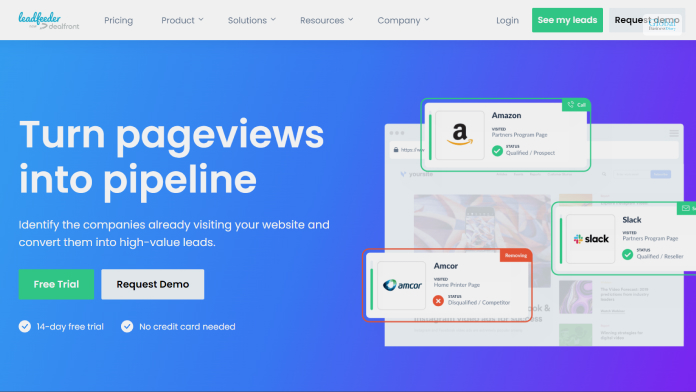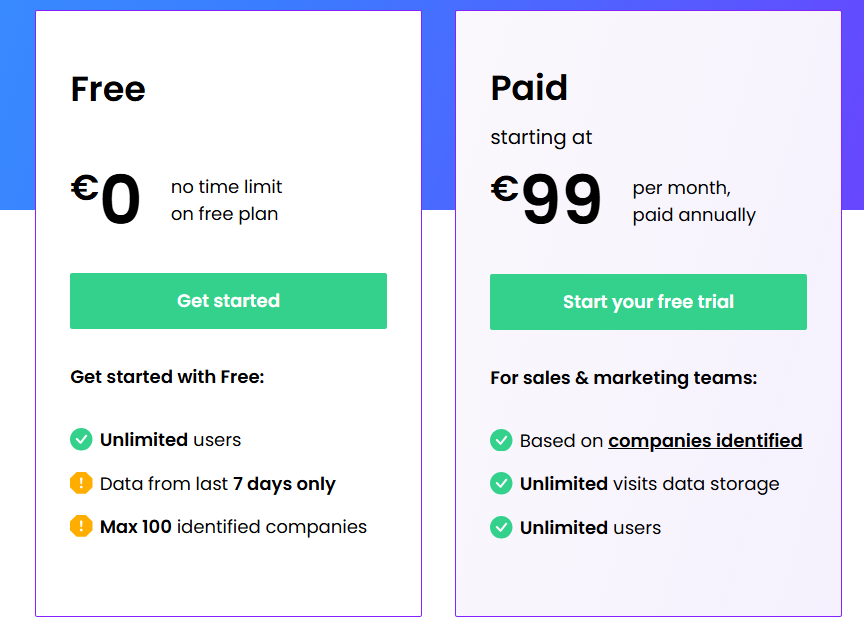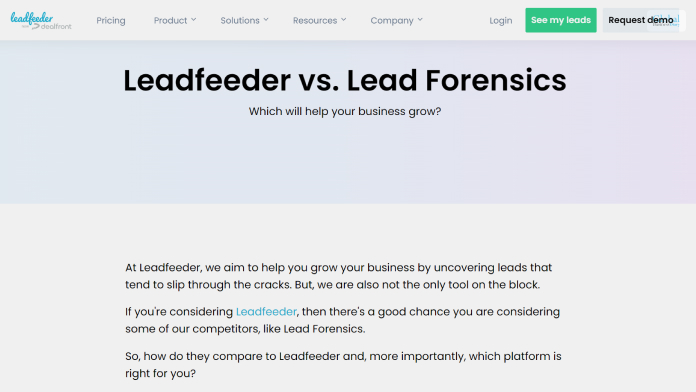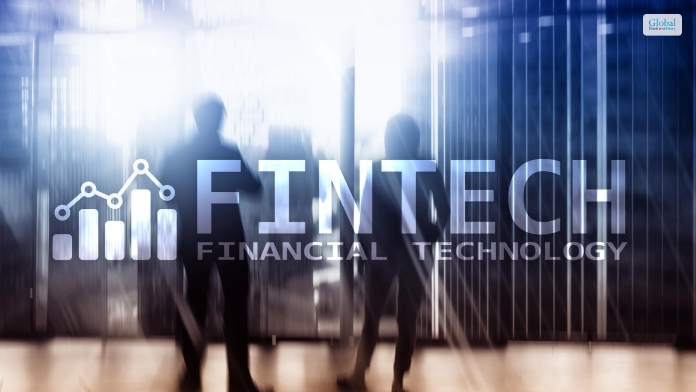- Home
- Technology
- Leadfeeder 2023 Costs, Specifications, Evaluations, And Alternatives
Leadfeeder 2023 Costs, Specifications, Evaluations, And Alternatives

Leadfeeder is a software platform where you can generate leads and essential reports and analyze marketing trends. Once you do a Leadfeeder Login, you will find various tools that will help you to increase your business’ productivity and sales. It uses a network domain from Google Analytics, with the help of which you can get access to quality leads for your business.
In this article, you will get a review of Leadfeeder B2B. The first part comprises a general overview of the software platform. Then, we will explain the pricing of the app as well. Next up, we will share with you the major features of Leadfeeder, in addition to a comparison with another platform called Leadforensics.
Furthermore, you shall learn the pros and cons of Leadfeeder. Finally, we will share the biggest alternatives you will find in regard to the software. Hence, to learn more about this software, read on through to the end of the article.
Leadfeeder – A General Overview

According to the official website of the platform,
“Leadfeeder is a website tracking script that combines data from your website and Google Analytics to tell you not just who visited your website but where they work, how long they stayed on your site, what pages they visited, and whether or not their company matches your ideal customer profile.”
The website helps you to find out the leads that can help your business to grow. The website platform comes with software tools that you can use to filter your leads for your business. Hence, you shall be able to locate the best options for your business, the ones that are of the best quality.
The automation features also help you to set alerts and come with various reporting features, which help you to identify those users that visited your site. You can then find out what are the candidates that are potential for sales.
Leadfeeder Pricing

According to Leadfeeder’s official website,
“Powerful data is great — but if that data stays siloed in a tool you never remember to check, then it won’t do you much good. Leadfeeder uses integrations to put the data we gather to where ever you need it most — whether that’s in your CRM, email platform, or even Slack.”
Once you try to purchase the services of the platform, you will get a free trial for 14 days. However, when it comes to pricing, there are two options – A free one and a paid one.
| Plan | Price |
|---|---|
| Free | €0 |
| Paid | Starting at:€199 per month (annual billing) |
Leadfeeder – What Are Its Major Features?

Many people try to compare Leadfeeder and Lead Forensics. However, in most cases, leadfeeder comes to the top. The following are some of the major features of Leadfeeder that you must know:
- The website platform offers you transparent payment terms, which is not available with many other alternatives. You will only pay for the leads that Leadfeeder identifies for you.
- There is an all-time free plan that this platform offers you. Furthermore, in the first seven days, you can avail yourself of the best features as well.
- The automated features offer you notify you about your leads and opportunities. You can set up notifications as per your needs.
Apart from these features, Leadfeeder also offers you customer support as well. According to the official website,
“We offer live support via chat and email from support hours are 10:00 AM – 11:59 PM EET (3 AM – 5 PM EST), Monday to Friday, excluding holidays or special events.”
Leadfeeder Vs Lead Forensics – Major Features

Most of the basic features are similar between Leadfeeder and Lead Forensics. However, there are some major differences that need to be highlighted:
- Leadfeeder offers you data about lead scoring, while Lead Forensics does not.
- Although Lead Forensics offers you Slack integration, it provides you with a third-party platform.
- The Google Analytics Integration of Lead Forensics also comes with a third-party source.
- Lead Forensics offers you less number of CRM integrations as compared to Leadfeeder.
- The cost of Lead Forensics is almost four times as high as compared to Leadfeeder.
Hence, you can see from here that Leadfeeder is the clear leader when it comes to the features offered in one platform. Furthermore, on various review platforms, we have seen that Leadfeeder is the sure winner.
Major Pros And Cons Of Leadfeeder

According to Compare Wise,
“(Leadfeeder) is a great way to stay ahead of the competition by becoming aware of the various companies and their needs. You’ll have access to each potential client’s information for the contact, which gives your business an opportunity ahead of others.”
Here are the major pros and cons of Leadfeeder that you must know of:
Pros Of Leadfeeder
The following are the major pros of Leadfeeder that will benefit your business a lot:
- There is a free option available but with limited features. However, if you are a solopreneur or a freelancer, this option is great for you.
- With high-grade analytic tools, you will get a better potential to increase your sales.
- Leadfeeder helps you to organize your sales funnel better.
- You will have the option to get real-time insights and valuable data.
Cons Of Leadfeeder
The following are some of the cons of Leadfeeder that you must be aware of:
- The premium option available is a bit high. However, it comes with enough features for a business to get amazing insights.
- Not beginner-friendly. You will need to strategize beforehand if you want to make the most out of Leadfeeder.
Leadfeeder Competitors
The following are the major competitor alternatives of Leadfeeder that you must know of:
- Affinity
- Intercom
- Leadpages
- Kajabi
- Pipedrive
- Lusha
- LeadIQ
- Salesforce Marketing Cloud Account Engagement
- Hunter
- Lead Forensics
Summing Up
Hope this article was helpful for you in getting a better idea of Leadfeeder as a software platform for better lead generation. If you want affordable software to get high-quality data and analytics related to your leads on your website, this one is the best platform for you. Share your own reviews regarding the platform in the comments section below.
Soumava Goswami
Inspired by The Social Network, Soumava loves to find ways to make small businesses successful – he spends most of his time analyzing case studies of successful small businesses. With 5+ years of experience in flourishing with a small MarTech company, he knows countless tricks that work in favor of small businesses. His keen interest in finance is what fuels his passion for giving the best advice for small business operations. He loves to invest his time familiarizing himself with the latest business trends and brainstorming ways to apply them. From handling customer feedback to making the right business decisions, you’ll find all the answers with him!
Recent
Preserve More, Waste Less: How Thoughtful Packaging Helps Protect Your Food, Your Health, and the Environment
Nov 22, 2025

Strengthening Corporate Sustainability Through Smarter ESG Reporting
Nov 21, 2025

The AI Revolution: How Industries Are Driving Innovation?
Nov 20, 2025

The Overlooked Bottleneck: Why the First 100 Feet Deserve More Attention
Nov 19, 2025

Related Articles

Evolution Of Fintech: A Complete Story Of Start To Rise
Do you want to know the evolution of Fintech technology, its rise and fall? If yes is the reply from your end, then read this article, and you will get the complete insight of Fintech Evolution. Fintech is the combination of Financial Services and Information Technology. You need to know the combination of the two concepts to make things happen in your way. Without knowing the facts, things can become more difficult for you in the long run. The evolution of Fintech carries the legacy of different eras. Thus, it makes the process of evolution more concrete to meet the current needs of the users. You can take inspiration from history to make your way forward in the future. However, it is one of the Growing Industries in USA. History Of Evolution Of Fintech No big evolution can take place overnight, as is the case with Fintech evolution. 1866 to 1967 were the time of Fintech technology's commencement. Since then, the Evolution of Fintech has been moving at a faster pace. Let’s find out the details one after the other to get a clear insight into it. 1. Evolution Of Fintech From 1866 To 1967 Significant advancements in the financial industry marked the period from 1866 to 1967. Although the term "fintech," as we know it today, was not used during this time. The telegraph, invented in the 19th century, revolutionized long-distance communication. It enabled faster transmission of financial information, such as stock prices and market news, facilitating more efficient trading and investment decisions. This was also the era of Financial Globalization that most of us are unaware of. In this year of railroads and steamships that allowed faster transmission of financial information worldwide. The key events of this timeline include the first transatlantic cable. This event took place in 1866. Fedwire in the USA was the first Electronic fund transfer system that initiated the process of transfer. The 1950s started the credit card system to initiate the electronic fund transfer process. American Express Company followed with the use of their own credit card in 1958. 2. Fintech Evolution From 1967 To 2008 This period is crucial due to the shift from analog to the digital transformation of traditional financial institutions. The first ATM was installed in the Barclays Bank. Along with it, this was the beginning of modern Fintech technology. The evolution of Fintech has gone through several courses of time to establish itself in a strong position. There were various significant trends that took place in the early 1970’s. You must be aware of it while attaining your needs easily. The 1970s saw the introduction of ATMs, which revolutionized how people access their money. In the 1980s, electronic stock trading platforms like NASDAQ emerged, changing how securities are traded. In 1973, SWIFT(Society For Worldwide Interbank Financial Telecommunication) came into existence. The widespread adoption of the internet in the 1990s led to the rise of internet banking and online trading platforms. Thus making financial services more accessible and convenient. The E-commerce business models came into existence in the 1990s as well. 3. Evolution Of Fintech From 2008- 2014 The beginning of 2008 was a new landmark in the Evolution of Fintech industry. You need to know the details of it to have a clear insight into it. From 2008 to 2014, there was a global economic crisis that morphed into a general one. Most people start to show their distrust of the traditional banking system during this time of year. This led to the layoff of employees from banks and other traditional services to keep things in order. The release of Bitcoin in 2009 was the new landmark for Cryptocurrency and digital currency. This was the new landmark of this evolution of fintech technology. You must know the facts from your end to have a clear insight into it. The proliferation of smartphones in the 2000s paved the way for mobile banking apps. The mobile payment solutions enable people to manage their finances on the go. You need to go through the facts while meeting your needs with ease. 4. Fintech Evolution From 2014- 2017 Fintech Evolution from 2014- 2017 is one of the landmark years for most people. Try out the best options that can assist you in reaching your requirements with complete ease. This was the key factor for digital banking all around the globe. With the improvement of Fintech Technology, how do they access the internet in the developing world? You must consider the facts that can assist you in reaching your requirements with complete ease. The popularity of digital wallets, such as Apple Pay, Samsung Pay, and Google Pay. This grew during this period, enabling users to make contactless payments using their mobile devices. You must ensure that the chances of errors are as low as possible. P2P payment platforms like Venmo, PayPal, and Square Cash gained popularity. Thus making it easier for users to send and receive money from friends, family, and businesses. 5. Evolution Of Fintech From 2018 to Today Blockchain Technology and open banking continue to drive innovation for future financial services. This can boost the scope of your brand value to the next level. The game changers were NEO banks. It almost challenges the complexity and pricing of traditional banks. Open banking initiatives have continued to gain momentum, particularly in Europe and other regions. These initiatives aim to increase competition and innovation by allowing third-party developers to access bank data and create new financial products and services. Embedded finance, the integration of financial services into non-financial products and services, has become increasingly prevalent. This trend has led to the rise of fintech partnerships and collaborations across various industries. Fintech has played a significant role in improving financial inclusion, particularly in emerging markets. Mobile money and digital payment solutions have helped expand access to financial services for underserved populations. Benefits Of Fintech Technology There are several benefits of Fintech Technology that you should know from your end. While you want to grow your business in the right order, you cannot ignore the importance of Fintech Business. 1. Improved Accessibility Fintech has made financial services more accessible to more people, especially those in underserved or remote areas. Digital banking and mobile payment solutions have enabled people to access banking services without needing to visit a physical branch. There are several top expert network companies who seek the assistance of Fintech business today. 2. Cost Savings Fintech companies often operate with lower overhead costs compared to traditional financial institutions. This can lead to cost savings for both businesses and consumers, as fees and charges may be lower. Fintech companies can save you time at the time of making costly transactions. 3. Increased Efficiency Automation and digitalization have improved the speed and efficiency of financial transactions. Processes that once took days can now be completed in minutes or even seconds. 4. Enhanced Customer Experience Fintech has revolutionized the customer experience in banking and finance. Mobile apps and online platforms provide users with convenient access to their accounts and financial tools. Thus, leading to higher levels of customer satisfaction. You may have a lack of skills to develop your business goals with ease. 5. Innovation & Customization Fintech companies are known for their innovative approaches to financial services. They often develop new products and services that cater to specific customer needs, leading to a more personalized experience. Although, with the application of innovation and development, things can become easier for you in the long run. 6. Financial Inclusion Fintech allows for more personalized financial services, with the ability to tailor products and recommendations to individual customer needs and preferences. You must understand reality if you want to meet your requirements with complete ease. It can boost your earnings chances to the next level. Without knowing the reality, things can turn worse for you in the long run. 7. Improved Security Fintech companies invest heavily in cybersecurity to protect user data and transactions, offering secure platforms for financial transactions. The financial data is very sensitive. So, if it falls into the hands of hackers, then your bank account can reflect zero balance. To get rid of Fintech data breach issues. Companies have to seek assistance from cybersecurity experts to reduce chances of data breaches. Why Evolution Of Fintech Technology Carries Problems Of Data Breaches? There are several reasons why Fintech Technologies carries the problems of data breaches. If you are not careful enough, then your valuable financial data will be under the clutches of Cyber criminals. Fintech companies often handle large volumes of sensitive financial data, making them attractive targets for cybercriminals. The complexity of fintech systems often involves multiple interconnected components and third-party services. This can create vulnerabilities that hackers can exploit. Many Fintech companies need to integrate with legacy banking systems. Thus, it may have outdated security measures that can be easier to breach. The lack of standardized security practices across the fintech industry can make it challenging to ensure consistent protection. Thus, your company becomes vulnerable to data breaches of sensitive financial data. Despite technological advancements, human error remains a significant factor in data breaches. Some of them are phishing attacks or improper handling of data. Fintech companies must comply with various regulations related to data protection and privacy. Thus, it can be complex and challenging to navigate. You must try to keep the things mentioned in mind while handling the activities of the Fintech business. Today, in the 21st century, Data is gold, and so you need to protect your data from hackers. Thus, it ensures financial security in your organization. How Ethical Hackers Protects Fintech Technology Business? There are several ways Ethical Hackers protect Fintech Technology Business from the clutches of hackers to a considerable extent. Additionally, you must be aware of the reality while you want to go through the facts with complete ease. Some of the core factors that you should know from your end are as follows: - 1. Identifying The Vulnerabilities Ethical hackers use their skills to find vulnerabilities in fintech systems, applications, and networks that malicious attackers could exploit. You can seek the assistance of ethical hackers who can help you in finding the vulnerabilities with complete ease. Thus, making things work in the correct order within a specific time. 2. Doing The Penetration Testing They conduct controlled attacks (penetration tests) to simulate real-world attacks and assess the security posture of fintech systems. This helps in identifying and fixing vulnerabilities before attackers exploit them. Furthermore, penetration testing will reduce the chances of phishing attacks on your database. 3. Having Security Audits Ethical hackers perform security audits to evaluate the effectiveness of security controls, policies, and procedures in place within fintech organizations. Without having security audits, you cannot figure out the source of phishing attacks on your database. Thus, you must keep your system and process free from spam and bugs. 4. Getting The Recommendations For Improvement Based on their findings, ethical hackers provide recommendations and best practices to improve the overall security posture of fintech businesses. You can get the recommendation for your improvement in data security if you seek the assistance of an ethical hacker. Try to keep things in place while meeting your needs. Furthermore, for your smooth pipeline in finance you need to seek recommendations. 5. Compliance Ethical hackers help fintech businesses comply with regulatory requirements and industry standards related to cybersecurity. Maintaining regulatory compliance will help you in meeting the evolution of Fintech technology to attain your requirements. 6. Having The Training & Awareness They may also provide training to employees to raise awareness about cybersecurity threats and best practices. Keep the training and induction program in place within your organization if you are running the Fintech business. Otherwise, you may have to face the situation of data compromise in the long run. Final Take Away Hence, if you want to go through the evolution of Fintech Technology, you must consider the mentioned facts. This can boost the chances of your Fintech Business development in the long run. You can share your opinions and views in our comment box. This will help us to know your opinion regarding this matter. Without knowing the facts, you cannot make the wrong selection. Overall, ethical hackers play a critical role in helping fintech businesses protect their technology infrastructure, maintain regulatory compliance, and build trust with their stakeholders. Try to keep things in perfect shape while meeting your needs. For More Business Related Article: Pro Rata: Definition, Uses, And How To Calculate It? What Is The Leverage Ratio And How to Calculate It? Trial Balance: Definition, Working, Importance, And More
Feb 22, 2024

Rippling: How They’ve Changed HR Software?
Even though transitioning to a brand-new payroll system can be a significant challenge for many companies, there are typically valid reasons to go through Rippling. For example, Selecting a great payroll provider that can scale alongside your business and offers all the necessary features for both your current needs and future growth is crucial. A top-notch payroll provider can also adapt to your business needs and contribute to your success. They can be perfect for you when it comes to tackling evolving requirements. That’s why choosing Rippling is a great decision due to its all-encompassing HR suite, which covers recruiting, headcount planning, time-attendance, and more. It allows the organization to process payroll within the same system used for other HR functions. In this guide, we'll tell you about how Rippling has changed the entire HR software industry. We have literally tested it, so that we can offer the perfect review and help you sell rippling stock in a decisive manner. In any case, if you still have any question after going through the article, we’d encourage you to comment below. So, without any further ado, let’s get started! Chapter – 1: What is Rippling? Rippling is a platform for managing employees that transforms the sometimes-difficult job of handling people operations into a smooth digital process with the aid of intuitive automation. Using the platform, employers can - Send offer letters, Conduct background checks, Gather new-hire documents, Add workers to the payroll, and Facilitate health insurance enrollments. The platform can also assist in ordering and delivering work equipment to new employees, providing them with essential tools like Google Workspace and Microsoft Office 365 to ensure their success. This makes it a nice choice for integrating remote, hybrid, or in-person employees. Chapter – 2: The Benefits of Rippling A: Ease of Usage One of Rippling's top characteristics is its user-friendliness. Navigating the platform's dashboard is easy due to its intuitive design. You and your human resources team can simply generate tasks, allocate them to the right workers, and oversee them all from this single interface. During software testing, we appreciated the ability to automate workflows for important HR tasks. It is great for expediting your HR procedures and minimizing the risk of human mistakes. Furthermore, not only business owners and HR managers can benefit from Rippling. Employees can also use the cloud-based software to manage their personal HR tasks from any web-enabled device, saving time for managers and HR team members. Rippling also provides a mobile app for iOS and Android devices for your employees to handle and assess their HR tasks from anywhere. Adding to the system's remarkable user-friendliness is Rippling's ability to connect with over 500 third-party applications, allowing it to effortlessly work with numerous programs commonly used for business operations. B: Better Employee Onboarding Rippling makes the onboarding process easy and user-friendly, even for SME owners without a dedicated HR employee to oversee it. The CEO of Rippling allegedly personally hired each new employee through the platform. It provides a wide range of capabilities for every stage of the onboarding process, such as the - Offer letter, E-Verify, Payroll configuration, Benefits choices, and Onboarding forms. In our review of HR software, we discovered that employers can onboard new employees within minutes, making it the fastest onboarding process available. The onboarding process for employees is just as easy on their end. Employees can also complete all their new employee documentation on their mobile phone. We appreciate the ease and user-friendliness of the onboarding process for employees as well. The device management features of Rippling are beneficial for bringing on remote employees, making it an ideal option for the current remote work environment. Rippling also offers an applicant tracking system that enables employers to monitor applicant data and seamlessly convert it upon hiring, removing the necessity for entering data twice. C: Smoother Integration The general ledger is an essential documentation for efficient accounting, recording all payroll transactions like - Employee salaries, Direct deposits, Tax deductions, and Costs. Every time a payment is made to employees, it is documented in the main accounting record. It’s essential to guarantee a rather seamless integration between the general ledger and your payroll management system. And this is where Rippling can fit in perfectly for you. Utilizing a spreadsheet for the main accounting book may pose challenges related to mistakes, readability problems, and security vulnerabilities. A payroll system can streamline, combine, and retrieve data from other systems, removing the necessity for manual uploads and using the CSV template import/export process. Using Rippling, you can connect and synchronize information from other platforms without manual uploading. By using dynamic general ledger mapping, you can cut down on the amount of time spent reconciling each month by - Establishing tailored rules that link your payroll and expense data to your general ledger and Categorize each account's details automatically. Rippling also integrates seamlessly with accounting software like QuickBooks, Xero, Sage, and NetSuite to modernize and optimize your general ledger. To eliminate manual manipulation in the monthly closing process, you can synchronize payroll information with your general ledger in a format that includes class and job code specifics. Chapter – 3: The Features of Rippling A: Payroll If you wish to enhance your Rippling software to handle payroll calculations and execution, you can include complete payroll processing in your package, accessible in all 50 states. While evaluating the software, we discovered that Rippling's payroll functionalities are on par with those of the other platforms we examined. The payroll service offers - Automatic tax filing, Direct deposit, Workers’ compensation insurance, Reimbursements, Deductions, Garnishments, Year-end tax forms, and New-hire filing. It also allows you to monitor pay rates and job costing, assisting with staying compliant with I-9 and W-2 regulations. So, you’ll be safer from the government’s eyes too. B: Onboarding No other HR software platform compares to Rippling in efficiently expediting the onboarding process. Using this automated software, administrators can complete tasks such as - Sending offer letters, Filling out new-hire paperwork, Handling payroll, and Enrolling employees within just a few minutes from the main dashboard Rippling's smooth document management tools simplify the onboarding process even more. Key onboarding paperwork, such as offer letters and direct deposit paperwork, can be distributed to new employees. The act of signing them is also easy for new hires. After signing, the papers are uploaded to the worker's digital folder in the Rippling system. Employers have the option to establish guidelines in place to guarantee that every new employee gets all the necessary paperwork. For instance, companies might have varying editions of their employee manual tailored for staff in various states or nations. We particularly liked the automation of this process in Rippling, which automatically sends the appropriate handbook based on the hire's location. C: Offboarding Rippling also provides a robust employee offboarding procedure, which we consider crucial for a seamless transition when an employee leaves the organization. Employers can easily dismiss employees from the system and include notes about their departure rationale or rehire eligibility. They'll also have the option to pass on duties to another colleague within the platform for a seamless handover procedure. Rippling also permits administrators to change all a former employee's passwords to a chosen master password. It, in turn, ensures that they can access the accounts and prevents any former employees from accessing company accounts. D: Payroll We appreciated the fact that Rippling's automated deduction calculations and tax filings made it possible to run payroll quickly, in just a few minutes. Rippling can also aid in streamlining your payroll compliance by ensuring adherence to state or local regulations concerning wage, overtime, meal and rest breaks, and other requirements. A distinguishing factor of Rippling compared to other competitors we evaluated is its updated worldwide payroll functions. Rippling has introduced payroll services in five countries: Canada, Mexico, India, Germany, and the United Kingdom. It also offers payment options for contractors in more than 150 countries. E: Benefits Management Rippling simplifies the process for administrators to - Automatically enroll new employees, Make changes to payroll deductions, Set up contribution strategies, and Accomplish various other tasks directly from the home dashboard. New hires and current staff members who experience a qualifying life event can access guided enrollment options, featuring easy-to-use navigation and direct comparisons of your company's health and financial perks. The Final Chapter – The Recommendation Stature Our top choice is Rippling for ... Companies seeking all-in-one HR software with a core focus on automation, capable of seamlessly integrating with their current business software, benefits, and apps. Midsize businesses looking to streamline their HR processes, from onboarding to offboarding and everything in between, in order to save time and maintain accuracy. Businesses seek the versatility of a highly customizable HR software platform with a wide range of reporting options. We advise against using Rippling for ... Small businesses with low volume of repetitive HR tasks such as recruitment, orientation, resource distribution, benefits administration, and employee exits. Small and midsize businesses require extensive customer service assistance for managing and updating their operations-related tools and software. So, before you consider using Rippling, we’d ask you to evaluate your company as closely as possible. Also, talk to an expert and ask them if they think using the tool will do good for you. Read More: How To Choose The Right Stocks: Tips For New Investors Coinbase: Essential Things To Know About This Fintech Company Should You Consider Insuring Your Employees: Reasons And Tips
Apr 03, 2024

Real Estate Mobile App Development: Detailed Manual
Real estate mobile applications have experienced a tremendous surge in popularity in the past few years, owing to the ever-expanding estate sector. Real estate apps provide a bunch of features, such as property listings, virtual tours, mortgage calculators, and property management tools. These real estate mobile app development features make it easier for customers, salesmen, and representatives to interact and manage real estate transactions more efficiently. Real estate apps offer a level of convenience, accessibility, and online data to users. Buyers can investigate properties and view detailed information, images, and videos, as well as schedule virtual tours and connect with agents. Sellers can list the properties and connect with potential buyers straight through the property app. Agents can manage their listings, connect with clients, and track leads and sales with the assistance of the application. The development of such apps is highly lucrative, offering businesses a valuable opportunity to reach a broader audience, improve efficiency, and enhance customer satisfaction. In this article, we will delve into the topic of mobile app development for real estate industry. Сategories Of Real Property Apps You Should Know About The real estate mobile app development offers a large number of features that simplify real estate transactions for clients, salesmen, and representatives alike. With access to detailed property listings, virtual tours, mortgage calculators, and management tools, users can conveniently search for properties, view multimedia content, and connect with agents in real-time. For sellers, these apps allow them to list their properties and connect with potential buyers directly. Additionally, real estate agents take advantage of these apps to manage their listings, track leads and sales, and converse with customers. As a result, real property app development became an excellent way for businesses to expand their reach, enhance their efficiency, and improve customer satisfaction. Property Search Apps Property apps are accessible in various types, each with a unique purpose. One type is property search apps, which allow users to investigate properties by location, price range, and property type. Zillow and Airbnb are examples of property search apps that offer a comprehensive database of properties for sale and rent, providing users with precise data such as pictures, videos, and virtual excursions. Mortgage Calculator Apps Another type is mortgage calculator apps, which assist users in calculating the cost of a mortgage, which is based on various factors, such as the down payment, interest rate, and loan term. Mortgage Calculator by Quicken Loans is an example of a mortgage calculator app that enables users to calculate their monthly mortgage payments and see how different variables impact the overall cost of the loan. In addition, property management real estate mobile app development is widely used in the real property sector. These apps enable landlords and property managers to manage their properties, tenants, and leases using their mobile devices. Rent Manager is an example of a property management app that offers features like lease tracking, maintenance requests, and payment processing. Virtual Tour Apps Virtual tour apps are another type of real estate mobile app development that enables users to take a virtual excursion of a property, excluding the actual visit of it. These apps utilize virtual reality technology to provide a realistic and immersive experience of the property. Matterport is an example of a virtual tour app that creates 3D models of properties and allows users to navigate through them as if they were physically there. Real estate apps offer a variety of features that streamline real estate transactions, from searching for properties to managing them. With the appropriate real estate app, customers, salesmen, and representatives agents can improve their efficiency and effectiveness in the estate sector. Key Aspects Of Real Estate Mobile App To stand out in the crowded app market, it's crucial to have the following must-have features in a real property application: Property Search The property search feature provides users with the capability to explore listings based on their preferred location, type of property, and budget. This powerful tool gives users the ability to effortlessly and quickly find their ideal home by pinpointing properties within their desired price range. Virtual Tours The virtual property tour feature enables potential buyers to experience a 360-degree view of the property without the need for physical presence. This immersive experience allows users to gain a comprehensive understanding of the property. As a result, it saves clients and agents time while providing a more extensive experience to prospective buyers. Mortgage Calculator This feature helps buyers estimate the cost of a mortgage based on different variables such as the down payment, interest rate, and loan term. It also helps buyers make informed decisions before making an offer on a property. Push Notifications Push notifications to keep users informed of new property listings, price drops, and other important updates. They help users keep abreast with the latest information. Secure Payment System A secure and easy-to-use real estate mobile app development payment system is necessary for processing rental payments, security deposits, and other financial transactions related to real estate. This feature ensures the safety and convenience of both clients and salespeople. By incorporating such capabilities within a real estate mobile application, businesses can enhance user engagement, elevate customer satisfaction, and boost sales in the fiercely competitive real estate market. Real Estate Mobile App Development: What are the Costs Involved App Design A well-designed user interface and user experience are crucial to the success of a real estate mobile app. The more user-friendly and visually appealing the app, the higher the cost. Features And Functionality The cost of developing a real estate mobile app depends on the various features and functionality you want to include. For example, advanced features such as virtual tours, mortgage calculators, and property management tools can increase the cost. Platform The cost of real estate mobile app development varies based on the platform you want to build it on. Building an app for both iOS and Android will cost more than building one platform. Development Team The cost of hiring a real estate mobile app development team is a significant factor in the total cost of developing a real estate mobile app. The more experienced the team, the higher the cost. Maintenance And Updates Once it is developed, you need to maintain and update it regularly to keep it relevant and competitive. The cost of maintenance and updates can vary based on the complexity of the app and the frequency of updates. Conclusion The success of a real estate app relies on its ability to deliver a seamless user experience and provide unique features. A user-friendly interface, personalization, advanced features, and effective marketing strategies can help achieve these goals. Additionally, it is crucial to regularly update and maintain the real estate mobile app development steps to ensure it meets users' changing needs and stays up-to-date with the latest technology. Gathering feedback from users and incorporating their suggestions can also help improve the app's success. Finally, building trust with users by ensuring the security and privacy of their data is crucial to the success of a real estate app. Businesses should prioritize data protection and transparency in their practices to gain users' trust and loyalty. Read Also: How To Get Personal Loan On Bajaj Markets Best Practices For Mobile Data Collection: Tips And Tricks How Sustainability Sets Up Real Estate Developers For Success
Mar 28, 2023

DevOps Architects: Defining Roles And Responsibilities In Modern Tech
Technology is a fast-paced and ever-evolving landscape, and DevOps architect roles and responsibilities have become increasingly crucial to the industry. DevOps architects bridge the development and operations teams, ensuring that development processes are seamlessly integrated when both teams embark on the software development lifecycle. In this article, we will delve into the core responsibilities, evolving trends, key skills, and other nuances that define the roles and responsibilities of DevOps architects in modern tech environments. We will also explore what it means to be a DevOps architect and the crucial nature that surrounds the software development skill. Overview of the Roles of DevOps Architects DevOps architecture is a holistic approach that seeks to unify software development (Dev) and IT operations (Ops). The goal of a DevOps architect is to shorten the system development life cycle and continuously deliver high-quality software. DevOps architects are critical in designing and implementing these practices by ensuring seamless collaboration and communication between operations and development. Core Responsibilities of DevOps Architects The DevOps architect job description carries a multifaceted set of responsibilities, from strategic planning to hands-on implementation and collaboration. At the center of their responsibility is the need to streamline and optimize the software development process. By streamlining, DevOps architects ensure a quick, neat, and seamless development process, with hassle-free continuance, even if software development teams are changed mid-project. This involves defining and managing the deployment pipelines, implementing automation for continuous integration and continuous delivery (CI/CD), and orchestrating crucial workflows, DevOps architect responsibility is also to foster a culture of collaboration and communication, breaking down technical and traditional barriers between two core teams – development and operations. A successful DevOps-integrated software development process achieves a more efficient and agile development process. Key Skills and Competencies of DevOps Architects To effectively navigate the complex landscape of modern technology, DevOps architect responsibilities include technical proficiency and deep understanding of infrastructure as code, cloud computing, and containerization. They should be adept at utilizing various tools and technologies, like Kubernetes, Docker, Jenkins, and Ansible, to automate and streamline workflows seamlessly. While technical skills are necessary, DevOps architects must also excel in soft skills, including effective communication, collaboration, and problem-solving. They must be able to adapt to a continually changing software environment, learn the essentials of software infrastructure and collaboration, and survive in an environment where technology is in a constant state of evolution. Collaboration with Development Teams Business DevOps architects play a crucial role in fostering collaboration within development teams, striving to seamlessly integrate DevOps practices into the intricate world of the software development process. Their work involves close partnerships with developers, delving deep into the intricacies of application requirements. This collaborative journey goes beyond merely focusing on technical aspects; it's about cultivating a shared culture of responsibility and ownership. In this relationship, DevOps architects don't just guide on optimizing code for deployment; they actively champion a sense of shared responsibility. This means going beyond the lines of code and encouraging developers to take ownership of their creations throughout the entire lifecycle — from the initial stages of development through the deployment phase and beyond. This approach transforms the development landscape into a dynamic ecosystem of shared goals and mutual accountability. The collaborative ethos embraced by DevOps architects becomes a catalyst for a culture where every team member feels a sense of ownership in the project's success. It's not just about writing code; it's about cultivating a mindset where everyone is invested in the journey, understanding the nuances of each line of code, and appreciating how it contributes to the broader objectives of the project. This shared responsibility culture is particularly pivotal in achieving the agility and speed demanded by modern tech environments. DevOps isn't just a set of practices; it's a mindset, a culture that encourages continuous collaboration, learning, and improvement. DevOps architects empower developers to transcend the traditional boundaries between development and deployment by fostering this culture. Imagine a scenario where developers write code and actively engage in the deployment process, understanding how their contributions shape the end product. DevOps architects facilitate this by instilling a mindset where developers are more than code creators; they are stakeholders in the entire lifecycle. This enhances the efficiency of CI/CD pipelines and contributes to a more robust and resilient software development process. Partnership with Operations Teams Beyond their collaboration with development teams, DevOps architects embark on a strategic partnership with operations teams, creating a harmonious synergy that optimizes operational workflows and elevates application deployment and maintenance efficiency and reliability. This collaboration isn't just about sharing a workspace; it's about co-creating a seamless environment where development and operations converge for a common purpose—to develop quality software. In the world of DevOps architecture, stories abound of how this collaboration transforms the traditionally siloed landscapes of development and operations into a cohesive unit, each contributing to the other's success. Consider a dynamic tech company where DevOps architects and operations teams collaborate to streamline their operational workflows. They identified pain points in the deployment process through meticulous collaboration, addressing bottlenecks, and refining procedures. The result? An efficient operational system where applications were deployed with precision, reducing downtime and enhancing overall system reliability. This partnership is not just about problem-solving; it's about envisioning a future where operations seamlessly align with development goals. Often, with DevOps architects pushing for technical and traditional collaboration, cumbersome manual deployment processes can be converted into automated and more efficient processes. This not only reduces the burden on operations teams but also allows them to reallocate time to more strategic initiatives. The crucial factor in this partnership is Infrastructure as Code (IaC) practices, an innovative process in DevOps. Picture this: a DevOps architect introducing IaC to an operations team, unlocking the potential for infrastructure provisioning and configuration automation. In this narrative, the manual process of configuring servers and managing infrastructure becomes obsolete. Security Integration DevOps architects are responsible for integrating security measures seamlessly into the software development process. This involves implementing security best practices, conducting regular security assessments, and ensuring compliance with industry standards and regulations. For DevOps, security is crucial, not an afterthought. Conclusion DevOps architects play a pivotal role in the dynamic tech landscape, bridging development and operations. Their multifaceted responsibilities, from streamlining processes to fostering collaboration, define a human-centric approach. Collaborating seamlessly with operations teams, they transform workflows and champion security integration as a core element. As pioneers adapting to trends, DevOps architects guide teams toward shared success in the ever-evolving world of modern tech. Read Also: Business Venture Definition, Types, And How To Start? Why Business Continuity Planning Is Essential For Your Company? What Is Risk Management? – Find Out How To Manage Risks In Business
Dec 07, 2023





